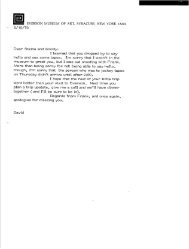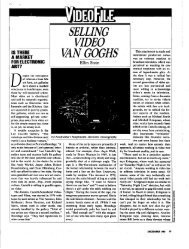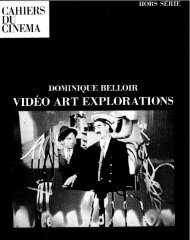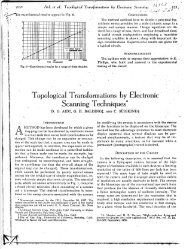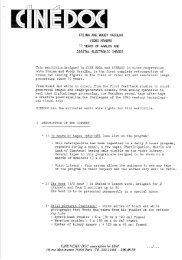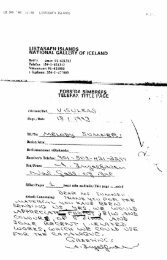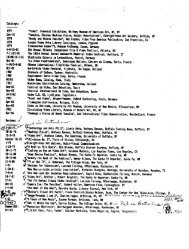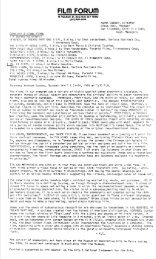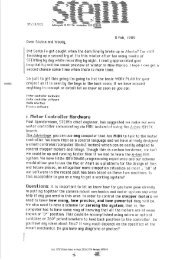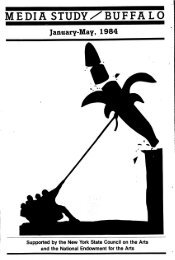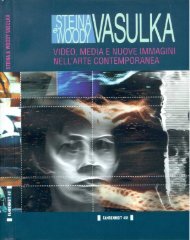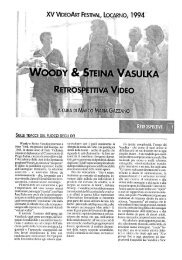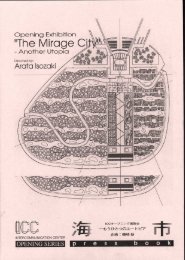Chapter 4: A HISTORY OF COMPUTER ANIMATION ... - Vasulka.org
Chapter 4: A HISTORY OF COMPUTER ANIMATION ... - Vasulka.org
Chapter 4: A HISTORY OF COMPUTER ANIMATION ... - Vasulka.org
You also want an ePaper? Increase the reach of your titles
YUMPU automatically turns print PDFs into web optimized ePapers that Google loves.
<strong>Chapter</strong> 4 : A <strong>HISTORY</strong> <strong>OF</strong> <strong>COMPUTER</strong> <strong>ANIMATION</strong> 3/20/92 2 2<br />
of clear core high contrast kodalith cels mounted on pegbar and<br />
backlit . A high resolution (1000 line) television camera captured<br />
this image and displayed it on a corresponding high resolution<br />
monitor where it be manipulated by the computer animator . The high<br />
resolution monitor was rescanned by a standard NTSC or PAL black<br />
and white camera, that is, the television camera was simply pointed<br />
at the high resolution screen and captured the image on it . Finally,<br />
the black and white video signal was quantized into five grey levels<br />
and colorized .] (fig . 47) .<br />
"Programming" the Scanimate involved neither keyboard, menu,<br />
nor language, but was accomplished by connecting the various<br />
modules together with patch cords . The high resolution display<br />
monitor was equipped with special deflection coils driven by a<br />
variety of oscillators, summing amps, multipliers, biases and other<br />
analog modules which twisted the monitor's raster electronics so<br />
that the image could literally be tied into knots . Basic source<br />
modules produced waveforms included sinewaves, sawtooth, square<br />
wave, and trangulars . Pulses could be generated of arbitrary<br />
frequency and duration . Temporal control-that is how the raster<br />
breathed-was provided by independent analog ramps which defined<br />
starting and end voltages and duration times ; these were patched<br />
into the oscillators et al to control them .<br />
Throughout the 1970s Harrison's CIC functioned both as a<br />
media producer and an equipment manufacturer . CIC's first<br />
commercial clients arrived in the late 1960's . [and add in example<br />
from Filmography .] Noteable artistic work included the films<br />
Growing (1970), and Scape-mates, made in 1972 by Ed Emshwiller<br />
(fig . 48) . In the production industry Scanimate became part of the<br />
emerging video production industry ; major production houses who<br />
installed Scanimate included Dolphin Productions in New York, Image<br />
West in Los Angeles, Far East in Tokyo, and RTL in Luxemberg .<br />
47 . Video synthesizer block diagram . Backlit artwork is scanned<br />
by high resolution camera and displayed on hirez black and white<br />
monitor . The deflection controls, greatly simplified in the drawing,<br />
control special deflection yokes in the monitor . The hirez monitor is<br />
in turn rescanned by an ordinary television camera, routed thru a<br />
colorizer, and recorded . An alternate input is black and white video<br />
to the hirez monitor . [illustration in hypercard ; consists of two<br />
cards] .<br />
48 . Analog computer animation . These frames from Scape-mates<br />
by Ed Emshwiller were made on a Scanimate machine and<br />
demonstrate its potential for rich <strong>org</strong>anic form . [locate]



